Birdfinding.info ⇒ Widespread and locally common across the South Pacific, mostly in the immediate vicinity of the islands where it breeds. Some of the more accessible sites include Australia’s Lord Howe and Norfolk Islands and Chile’s Easter Island. It is often seen on pelagic trips from Queensland, Australia, such as those out of Southport. Uncommon to rare across a wide swath of the North Pacific, where it has been seen occasionally at Kilauea Point National Wildlife Refuge on Kauai between April and September.
Kermadec Petrel
Pterodroma neglecta
Tropical and subtropical Pacific Ocean.
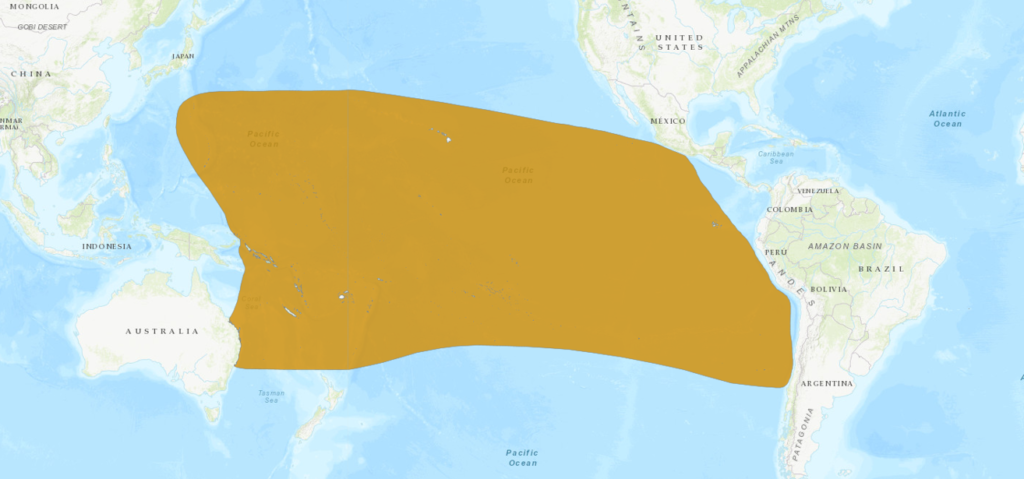
Approximate at-sea distribution of Kermadec Petrel. © BirdLife International 2018
Breeding. Breeds on several South Pacific islands and archipelagos between Australia and Chile: Lord Howe, Norfolk, Kermadec, Tuamotu, Pitcairn, Easter, Juan Fernández, San Ambrosio, and San Felix. Also in small numbers or sporadically at Round Island (Mauritius) in the Indian Ocean, and suspected on a few occasions at Kilauea Point on Kauai.
Nonbreeding. Disperses nearly throughout the tropical and subtropical regions of the Pacific roughly between 40° North and 40° South latitudes, usually remaining far offshore or near mid-oceanic islands.
In the North Pacific, it is known mainly from the western and central portions, around Japan’s offshore islands and Hawaii. Few confirmed records for North American waters include individuals visiting seabird colonies at South Farallon Island, California (September 8, 2017), and Isla Todos los Santos off of Baja California Norte.
Identification
A medium-large, stocky gadfly petrel that has several color morphs with highly variable plumages, but can usually be recognized by its distinctive underwing pattern.
The various plumage morphs each have essentially uniform upperparts, usually some shade of brown, sometimes warm but often ashy, sooty, or blackish (due to intrinsic variation plus the effects of feather-wear and lighting), and usually showing a white stripe across the base of the primaries.

Kermadec Petrel, pale morph, dorsal view. (Forty Mile Reef, Pitcairn Islands; September 6, 2013.) © North Thailand Birding
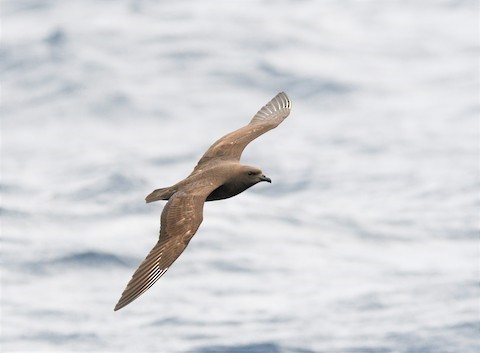
Kermadec Petrel, dorsal view of dark morph, appearing mostly warm-brown, showing white stripe at base of primaries. (Offshore from Southport, Queensland, Australia; August 15, 2020.) © Michael Daley
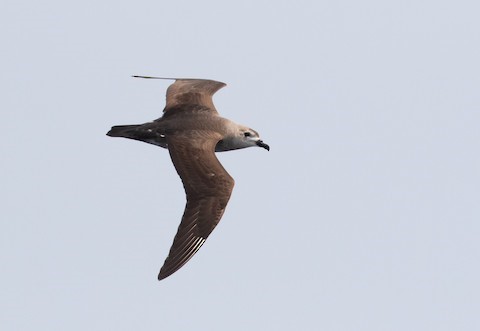
Kermadec Petrel, intermediate morph, dorsal view. (Offshore from Kiama, New South Wales, Australia; December 28, 2019.) © Richard Webber
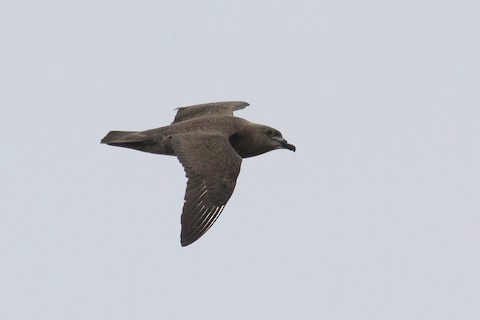
Kermadec Petrel, dorsal view of dark morph appearing sooty-brown. (Kilauea Point National Wildlife Refuge, Kauai, Hawaii; May 3, 2016.) © Jacob Drucker
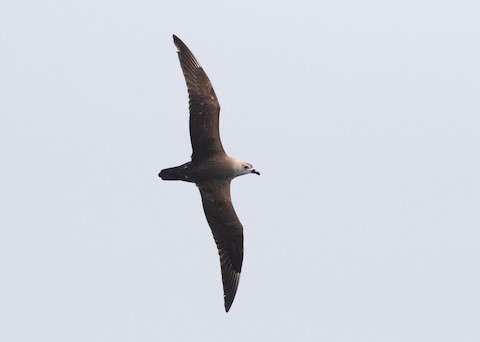
Kermadec Petrel, dorsal view of pale morph with wings fully spread, showing limited white at base of primaries. (Offshore from Kiama, New South Wales, Australia; December 28, 2019.) © Richard Webber

Kermadec Petrel, dorsal view of dark or intermediate morph appearing ashy-gray, showing white stripe at base of primaries. (Offshore from Southport, Queensland, Australia; April 28, 2019.) © Deborah Metters
The pale morph is mostly whitish on the head, neck, and underparts, usually an irregular pale-brown wash over the head, neck, and portions of the underparts.
Dark morphs are essentially all-dark, sooty to dark-brown or blackish nearly throughout, but often with a white or whitish area around the base of the bill.
There are two main types of intermediate morphs, uniform and hooded. The more uniform of these are some shade of medium-gray-to-brown overall, but usually with a blotchy, mottled texture.
Hooded intermediate morphs have a mostly whitish breast and belly, with a medium-gray hood that extends down to the chest, usually blending gradually to white on the breast. Most have a complete hood, though some individuals have a whitish throat.

Kermadec Petrel, pale morph with slightly darker hood. (Offshore from Southport, Queensland, Australia; August 15, 2020.) © Michael Daley
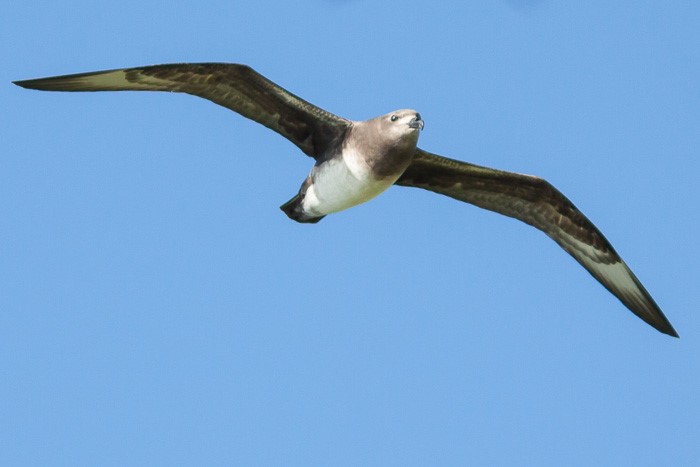
Kermadec Petrel, pale morph with slightly darker hood. (Oeno Island, Pitcairn Islands; September 9, 2013.) © North Thailand Birding

Kermadec Petrel, pale morph with slightly darker hood. (Offshore from Southport, Queensland, Australia; September 21, 2019.) © Jens Thalund
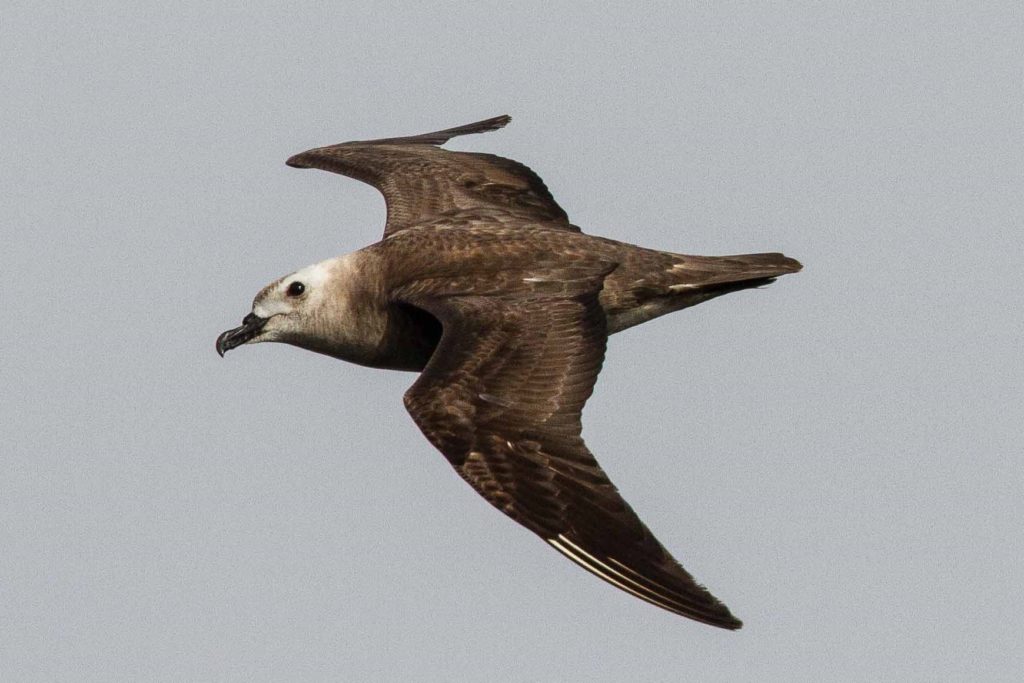
Kermadec Petrel, pale morph, dorsal view. (Kilauea Point National Wildlife Refuge, Kauai, Hawaii; July 31, 2014.) © Eric VanderWerf
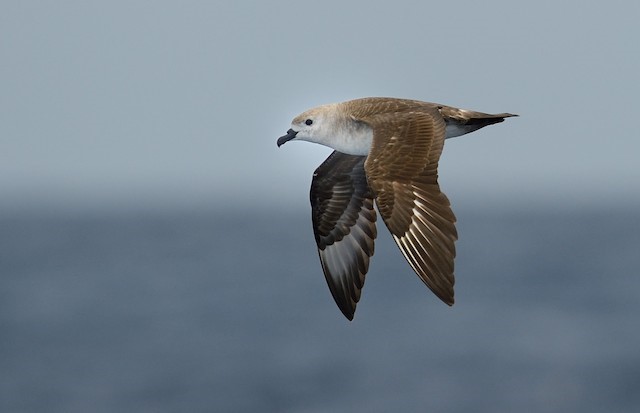
Kermadec Petrel, pale morph, showing white triangle on underwing and white stripe on upperwing. (North Cape, Northland, North Island, New Zealand; March 1, 2013.) © Kirk Zufelt
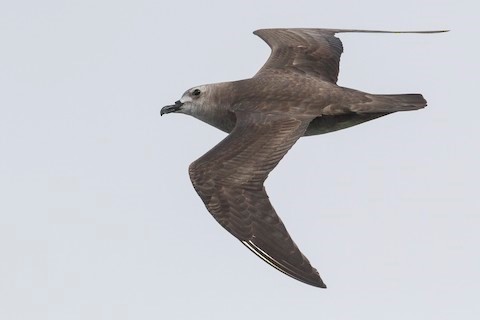
Kermadec Petrel, intermediate morph, dorsal view. (Kilauea Point National Wildlife Refuge, Kauai, Hawaii; May 3, 2016.) © Jacob Drucker
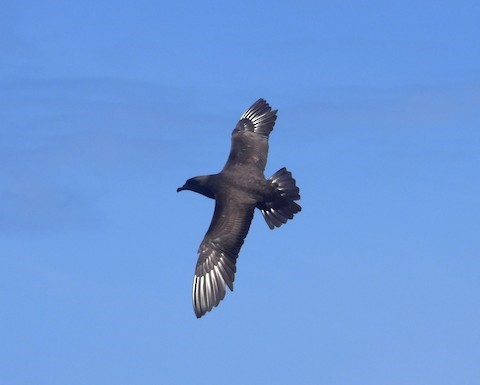
Kermadec Petrel, dorsal view of dark morph appearing blackish, showing white stripe at base of primaries. (Queensland Tablemount, offshore from Southport, Queensland, Australia; October 6, 2019.) © Chris Burwell
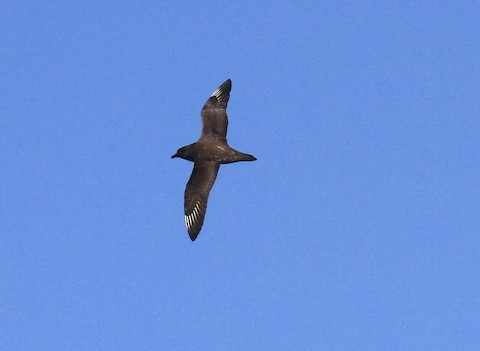
Kermadec Petrel, dorsal view of dark morph appearing blackish, showing white stripe at base of primaries. (Ball’s Pyramid, Lord Howe Island, Australia; January 17, 2017.) © Peter Sawyer
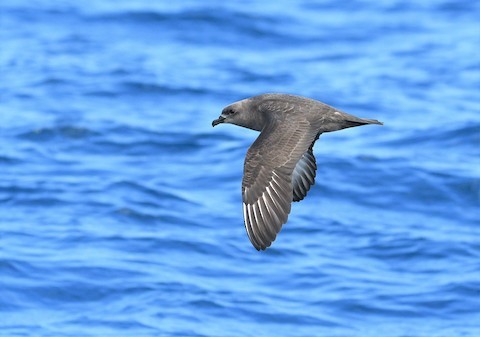
Kermadec Petrel, dorsal view of intermediate morph appearing mostly medium-gray. (Offshore from Southport, Queensland, Australia; September 13, 2020.) © Michael Daley

Kermadec Petrel, dorsal view of pale morph, showing white stripe at base of primaries. (Offshore from Southport, Queensland, Australia; August 15, 2020.) © Michael Daley
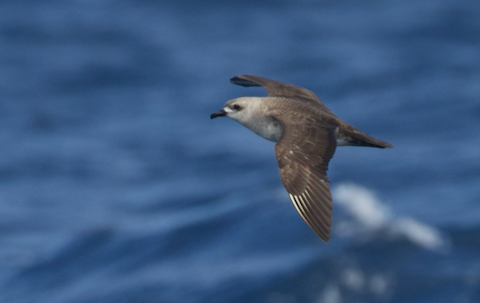
Kermadec Petrel, dorsal view, dorsal view of pale morph. (Offshore from Auckland, North Island, New Zealand; January 21, 2014.) © Adrian Boyle
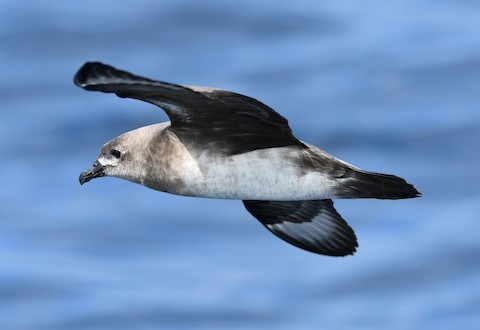
Kermadec Petrel, pale morph with slightly darker hood. (Offshore from Southport, Queensland, Australia; September 13, 2020.) © Michael Daley

Kermadec Petrel, pale morph with slightly darker hood. (Oeno Island, Pitcairn Islands; September 9, 2013.) © North Thailand Birding

Kermadec Petrel, ventral view of dark morph. (Forty Mile Reef, Pitcairn Islands; September 6, 2013.) © North Thailand Birding
In comparison to the seven or so other petrels that resemble particular morphs (see below), Kermadec’s underwing pattern is the most important feature. All color morphs share essentially the same pattern: dark overall with some white mottling and striking, immaculate white triangles in the primaries—framed with dark edges on all sides. On the rest of the underwing, the balance between dark and pale can vary to some degree. The white triangle in the primaries varies in size and shape, but its presence is a consistent feature.
The upperside of the wing also has a distinctive bright white marking: a stripe across the bases of the primaries.
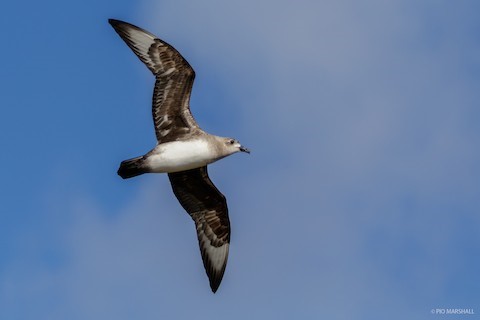
Kermadec Petrel, pale morph showing characteristic white triangles on primaries. (Motu Nui / Motu Iti, Easter Island, Chile; June 11, 2018.) © Pio Marshall
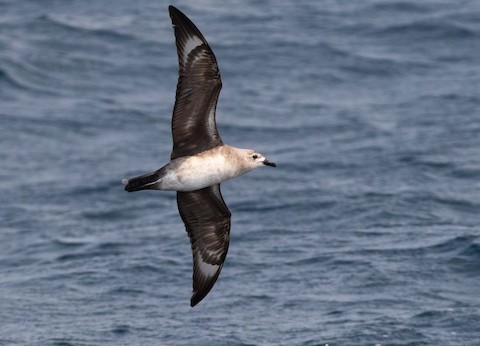
Kermadec Petrel, pale morph showing atypically small white triangles on primaries. (Offshore from Kiama, New South Wales, Australia; December 28, 2019.) © Richard Webber
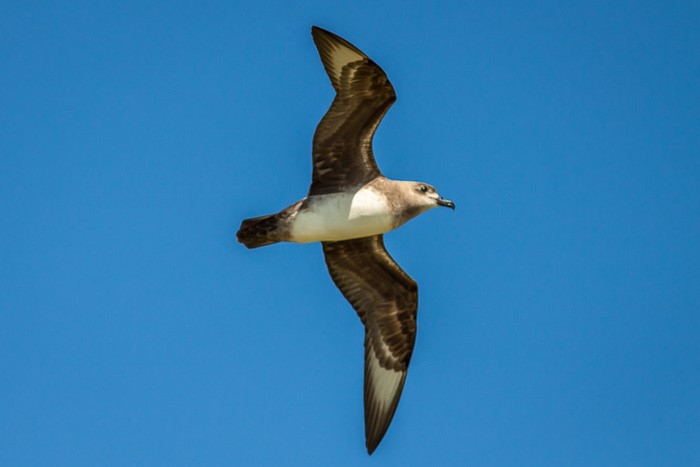
Kermadec Petrel, pale morph with darker hood, showing characteristic white triangles on primaries. (Oeno Island, Pitcairn Islands; September 9, 2013.) © North Thailand Birding
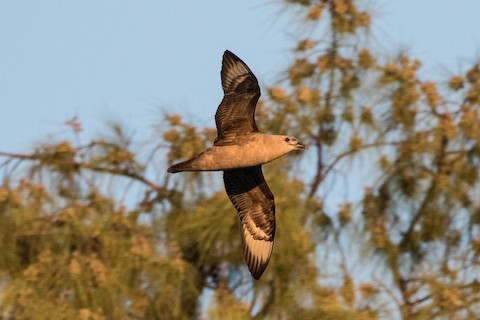
Kermadec Petrel, pale or intermediate morph showing characteristic white triangles on primaries, in Bonin Petrel colony. (Midway Atoll National Wildlife Refuge, Hawaii; October 2, 2019.) © Eric VanderWerf

Kermadec Petrel, pale morph showing characteristic white triangles on primaries. (Brittania Seamount, offshore from New South Wales, Australia; October 5, 2019.) © Gus Daly
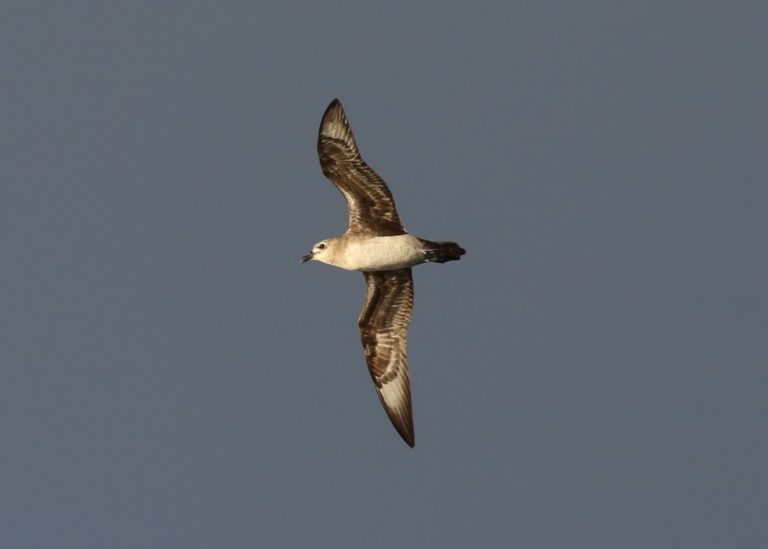
Kermadec Petrel, pale morph showing characteristic white triangles on primaries. (Kermadec Islands, New Zealand; April 3, 2016.) © Katy Johns

Kermadec Petrel, intermediate morph showing characteristic white triangles on primaries, prominent at long range. (Offshore from Noumea, New Caledonia; March 23, 2009.) © Nigel Voaden
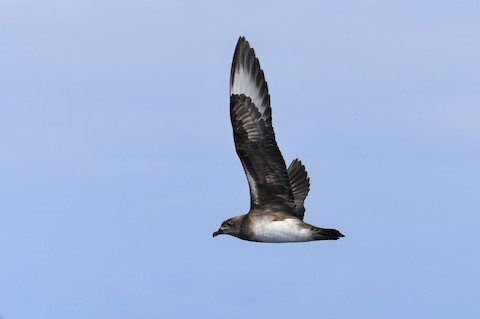
Kermadec Petrel, intermediate morph with dark hood showing characteristic white triangles on primaries. (Offshore from Southport, Queensland, Australia; September 13, 2020.) © Michael Daley
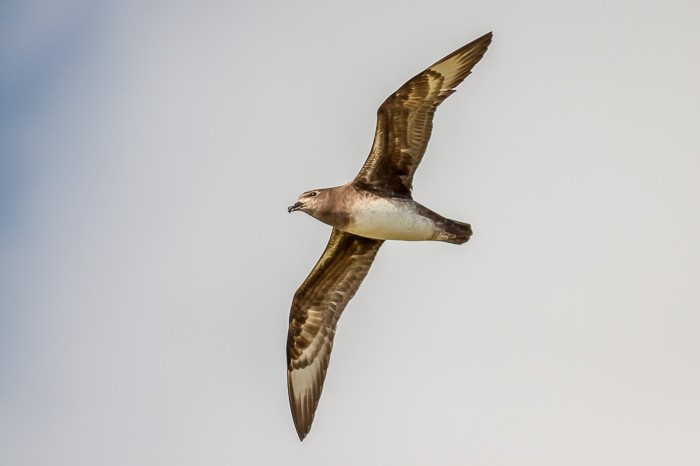
Kermadec Petrel, pale morph with darker hood, showing characteristic white triangles on primaries. (Oeno Island, Pitcairn Islands; September 9, 2013.) © North Thailand Birding
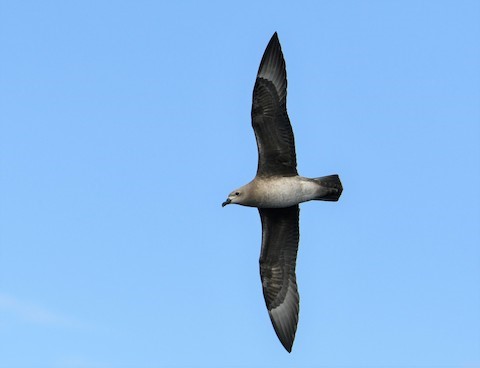
Kermadec Petrel, pale morph with slightly darker hood, showing atypically small white triangles on primaries. (Offshore from Southport, Queensland, Australia; August 15, 2020.) © Michael Daley
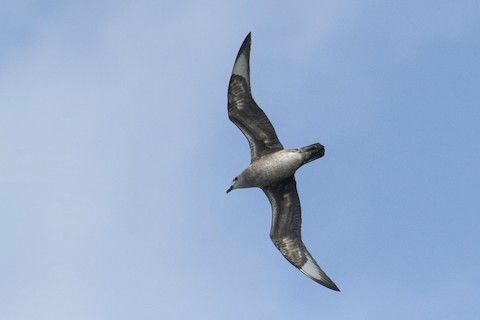
Kermadec Petrel, intermediate showing characteristic white triangles on primaries. (Kilauea Point National Wildlife Refuge, Kauai, Hawaii; May 3, 2016.) © Jacob Drucker
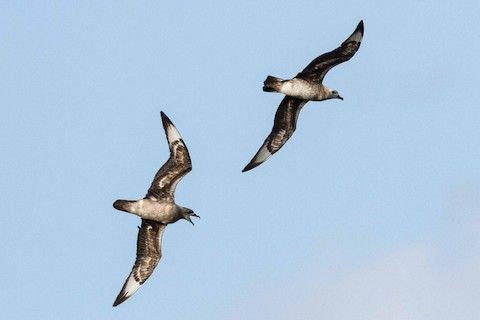
Kermadec Petrel, pair showing characteristic white triangles on the primaries. (Kilauea Point National Wildlife Refuge, Kauai, Hawaii; July 31, 2014.) © Eric VanderWerf

Kermadec Petrel, intermediate morph showing characteristic white triangles on primaries. (Kilauea Point National Wildlife Refuge, Kauai, Hawaii; April 11, 2015.) © Ben Lagasse

Kermadec Petrel, pale morph showing atypically small white triangles on primaries. (Offshore from Kiama, New South Wales, Australia; December 28, 2019.) © Richard Webber
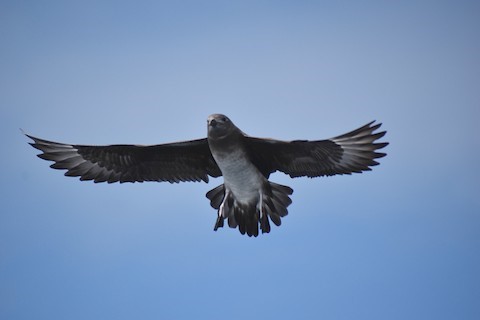
Kermadec Petrel, intermediate morph with darker hood, showing characteristic white triangles on primaries. (Offshore from Southport, Queensland, Australia; September 13, 2020.) © Don Pagotto
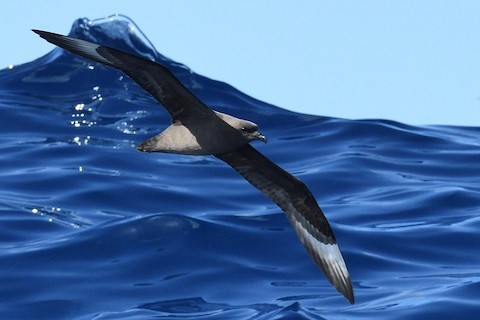
Kermadec Petrel, dark morph in shadow, but still showing characteristic white triangles on primaries. (Offshore from Southport, Queensland, Australia; April 28, 2019.) © Deborah Metters
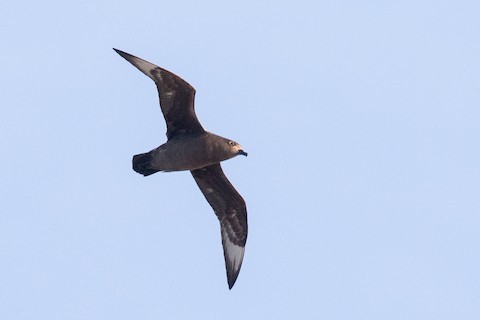
Kermadec Petrel, dark morph showing characteristic white triangles on primaries. (Motu Nui / Motu Iti, Easter Island, Chile; March 19, 2019.) © Garrett Lau

Kermadec Petrel, sooty-gray dark morph showing characteristic white triangle on the primaries. (Ball’s Pyramid, Lord Howe Island, Australia; December 15, 2013.) © Mat Gilfedder
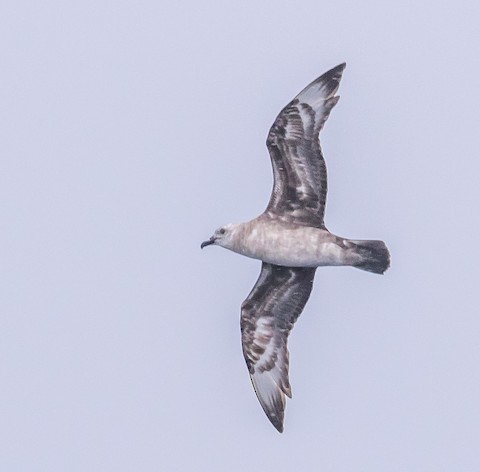
Kermadec Petrel, pale morph showing characteristic white triangles on primaries, but otherwise atypically messy underwings. (Offshore from Kiama, New South Wales, Australia; March 25, 2017.) © Louise Summerhayes
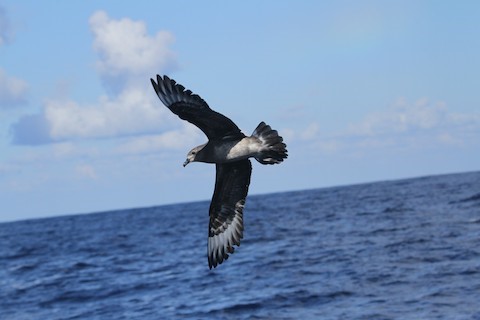
Kermadec Petrel, intermediate morph showing characteristic white triangles on primaries. (Ball’s Pyramid, Lord Howe Island, Australia; May 19, 2019.) © Peter Carr
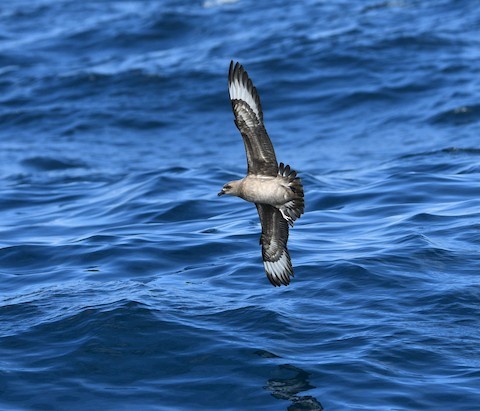
Kermadec Petrel, intermediate morph showing characteristic white triangles on primaries. (Offshore from Southport, Queensland, Australia; September 13, 2020.) © Michael Daley

Kermadec Petrel, dark morph, showing white triangle on underwing and white stripe on upperwing. (Offshore from Southport, Queensland, Australia; September 13, 2020.) © Don Pagotto
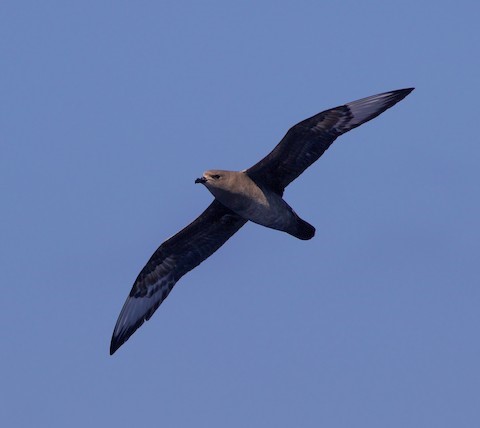
Kermadec Petrel, dark morph showing characteristic white triangles on primaries. (Ball’s Pyramid, Lord Howe Island, Australia; December 19, 2018.) © Liam Murphy
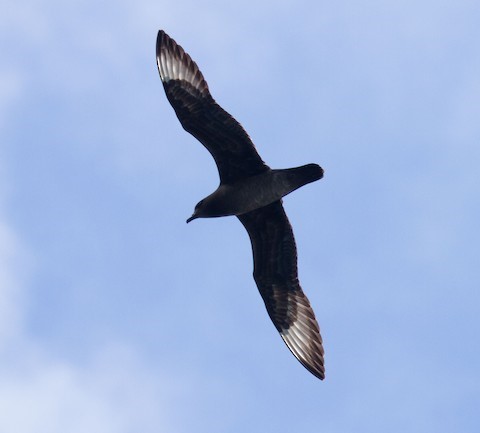
Kermadec Petrel, dark morph showing characteristic white triangles on primaries. (Robinson Crusoe Island, Chile; January 9, 2017.) © Fernando Díaz (Albatross birding Chile)

Kermadec Petrel, pale morph on nest. (Phillip Island, Norfolk Island; November 22, 2017.) © John Harris – Wildlife Experiences
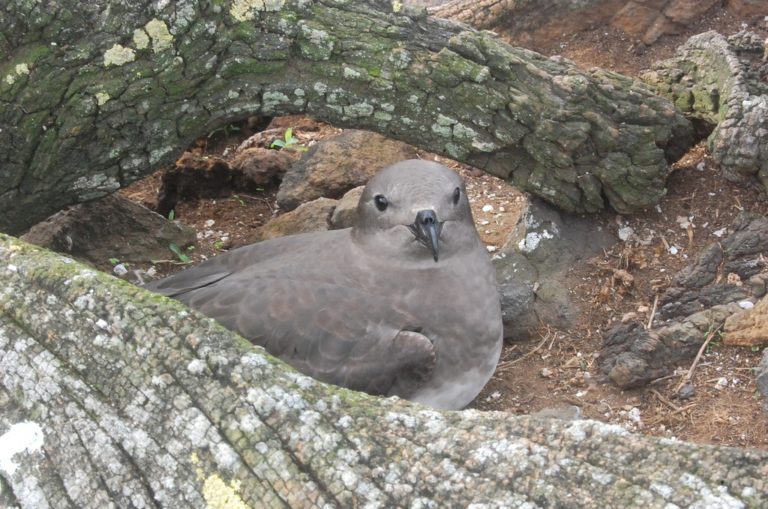
Kermadec Petrel, intemrediate morph on nest. (Kermadec Islands, New Zealand; May 16, 2011.) © Warren Chinn
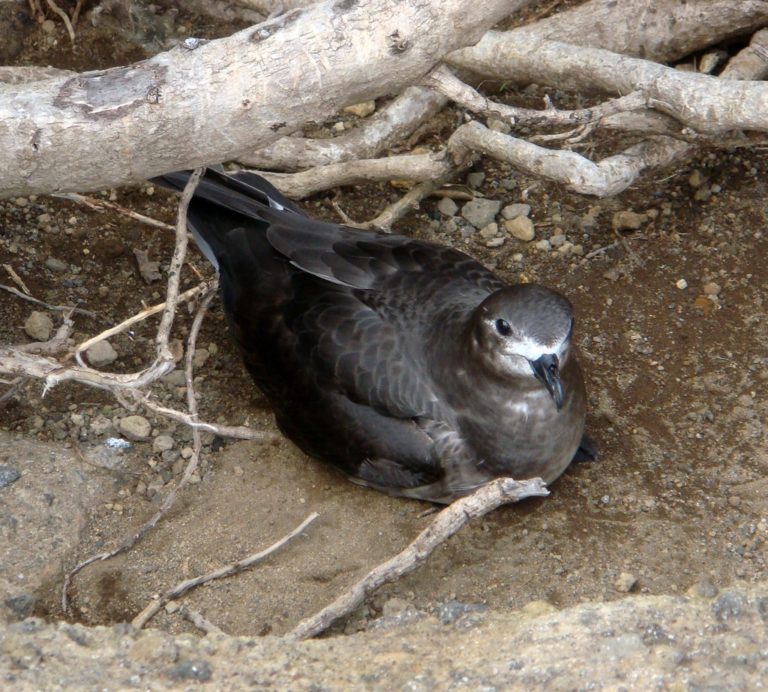
Kermadec Petrel, dark morph on nest. (Kermadec Islands, New Zealand; May 12, 2011.) © Peter de Lange
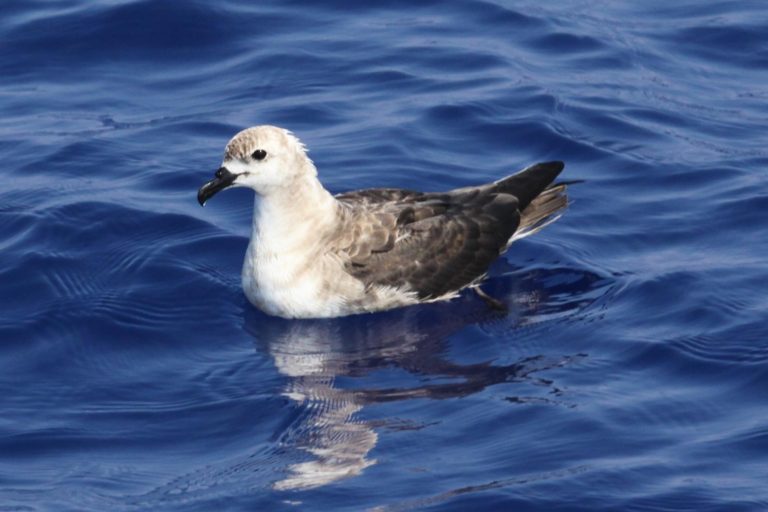
Kermadec Petrel, pale morph. (Offshore from Kailua-Kona, big Island, Hawaii; December 10, 2009.) © Daniel Webster – Cascadia Research Collective
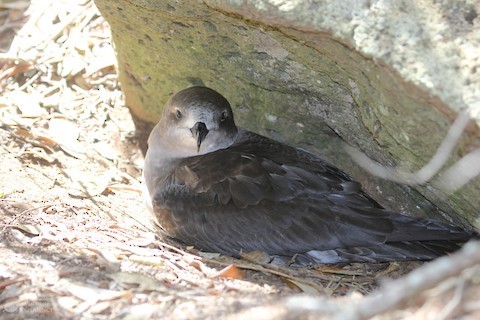
Kermadec Petrel on nest. (Phillip Island, Norfolk Island; November 22, 2017.) © John Harris – Wildlife Experiences
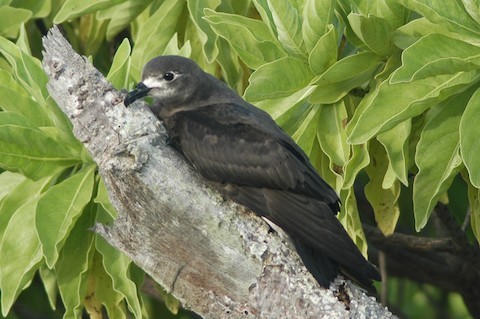
Kermadec Petrel, dark morph. (Morane Atoll, Gambier Islands, French Polynesia; March 9, 2003.) © Eric VanderWerf
Cf. Herald and Trindade Petrels. Herald, Trindade, and Kermadec Petrels are a closely related, confusing trio that can be difficult to identify in places where they overlap. Geography is the first clue: Trindade owns the Atlantic; Herald and Kermadec are widespread across the Pacific; and Trindade, Herald, and Kermadec all occur in small numbers in the Indian Ocean—all breeding, and to some extent interbreeding, beside Mauritius on Round Island.
Trindade and Kermadec Petrels both vary from pale-bellied (pale or intermediate morphs) to dark-bellied (dark morphs). Kermadec has a wider range of pale color morphs than Trindade, and some are distinctive. For the morphs that are generally similar between Kermadec and Trindade, their underwing patterns differ consistently. On Kermadec, the underwing is mostly dark, but mottled, and with a large, immaculate white triangle in the primaries, framed with dark edges, whereas on Trindade, the underwing has an overall pattern of dark leading and trailing edges with a paler strip in between, centered on the overlap between the wing linings and flight feathers.
Trindade’s underwing varies in the proportions of light and dark, but the general pattern is consistent—although on some dark morphs the underwing can appear nearly all-dark, and some light morphs have much more extensive white and a narrow dark trailing edge.
Herald Petrel is consistently (perhaps always) pale-bellied, and has an underwing pattern that is approximately intermediate between Trindade and Kermadec: mostly dark with a smaller white patch in the primaries and a slightly paler area across the base of the secondaries. Herald usually (perhaps always) has a whitish area that includes the lores and chin, which distinguishes it from both Trindade and Kermadec.
The upperside of the wing can be important for distinguishing Kermadec from the others. Kermadec consistently shows a white stripe across the base of the primaries, whereas Trindade and Herald have essentially unform upperwings.
Kermadec also differs from the other two in shape, as it usually appears much more robust, with proportionately shorter, broader wings and tail. It also tends to be more aggressive around some other species, often behaving like a skua (which it often resembles, but much smaller).
Cf. Providence and Murphy’s Petrels. Kermadec, Providence, and Murphy’s Petrels all occur over large portions of the Pacific Ocean. Providence is mostly in the western half and Murphy’s mostly in the eastern half, but they overlap in the center and Kermadec is widespread.
Dark morph Kermadec closely resembles both Providence and Murphy’s, and is intermediate in size between them. Providence and Murphy’s are more consistent in plumage, and both have white around the base of the bill—not always present on dark-morph Kermadec.
All three species share a similar underwing pattern: dark with a white triangle framed in the primaries. The differences are slight: Kermadec usually has more mottling on the innerwing and a more boldly framed and larger white triangle—but these details vary somewhat.
On the upperside of the wing, Kermadec has a bright white stripe across the bases of the primaries. Providence and Murphy’s rarely if ever show a comparable marking on the upperwing.
Cf. Henderson’s, Great-winged, and Gray-faced Petrels. Kermadec, Henderson’s, Great-winged, and Gray-faced Petrels overlap widely across large portions of the Pacific Ocean. Dark morph Kermadec resembles all of these species, though each of the others has its own more consistent plumage features.
Kermadec is generally distinguishable from the others by its underwing pattern: mostly dark, but mottled, and with a large, immaculate white triangle in the primaries, framed with dark edges. The others all tend to show more uniformly dark underwings, often with paler areas in the primaries, but generally not boldly framed white triangles.
Notes
Polytypic species consisting of two recognized subspecies.
References
BirdLife International. 2018. Pterodroma neglecta. The IUCN Red List of Threatened Species 2018: e.T22698027A132620272. https://dx.doi.org/10.2305/IUCN.UK.2018-2.RLTS.T22698027A132620272.en. (Accessed September 19, 2020.)
Brooke, M. 2004. Albatrosses and Petrels across the World. Oxford University Press.
eBird. 2020. eBird: An online database of bird distribution and abundance. Cornell Lab of Ornithology, Ithaca, N.Y. http://www.ebird.org. (Accessed September 19, 2020.)
Harrison, P. 1983. Seabirds: An Identification Guide. Houghton Mifflin, Boston.
Howell, S.N.G. 2012. Petrels, Albatrosses & Storm-Petrels of North America. Princeton University Press.
Howell, S.N.G., and K. Zufelt. 2019. Oceanic Birds of the World. Princeton University Press.
Jaramillo, A. 2003. Birds of Chile. Princeton University Press.
Onley, D., and P. Scofield. 2007. Albatrosses, Petrels & Shearwaters of the World. Princeton University Press.
Pratt, H.D., P.L. Bruner, and D.G. Berrett. 1987. A Field Guide to the Birds of Hawaii and the Tropical Pacific. Princeton University Press.
Pyle, R.L., and P. Pyle. 2017. The Birds of the Hawaiian Islands: Occurrence, History, Distribution, and Status. Version 2 (January 1, 2017). http://hbs.bishopmuseum.org/birds/rlp-monograph/. B.P. Bishop Museum, Honolulu, Hawaii.
Xeno-Canto. 2020. Kermadec Petrel – Pterodroma neglecta. https://www.xeno-canto.org/species/Pterodroma-neglecta. (Accessed September 19, 2020.)